Your camera sees the world in black and white; but a new astronomical camera sees the stars in color
Almost every imaging device on the planet (or in orbit, for that matter) sees the world in black and white: incoming photons hit the sensor, knock electrons loose, and generate a current. If the incoming photon’s energy is anywhere in the detector’s sensitivity range, the result is the same: the pixel is white.
To see color, imagers (including the human eye) integrate multiple black-and-white images made with defined parts of the spectrum. They either split the sensor field, using overlapping arrays of sensors with different filters to simultaneously make separate images—from red, green, and blue, for example—or they split the spectrum to project successive single-wavelength images on a single sensor field.
The Array Camera for Optical to Near IR Spectrophotometry (ARCONS) approaches the problem from a different angle, simultaneously capturing time and energy (and so wavelength) information from a single photon.
"What we have made is essentially a hyperspectral video camera with no intrinsic noise," says Ben Mazin, a physics professor at the University of California, Santa Barbara. Mazin—with UCSB colleagues and collaborators at NASA’s Jet Propulsion Laboratory, Oxford University, and Fermilab—is developing the ARCONS device for astronomical observation. "On a pixel-per-pixel basis, it's a quantum leap from semiconductor detectors; it's as big a leap going from film to semiconductors as it is going from semiconductors to these superconductors. This allows all kinds of really interesting instruments based on this technology."
The heart of ARCONS is a 60-nanometer-thick layer of titanium nitride (TiN) carried on a silicon base. Depending on the ratio of nitrogen to titanium, the layer becomes superconducting at about 1 Kelvin. (As the proportion of nitrogen decreases, the superconducting transition temperature and band-gap energies get lower; consequently, the imager's sensitivity to incoming photons increases. At its tiniest, the band gap of the superconducting TiN is about three orders of magnitude smaller than in a typical semiconductor.)
The TiN layer is etched into a 44 x 46 pixel array, and each pixel gets its own individually tuned microwave resonator and a microlens. The ensemble is enclosed in a lens-topped Dewar jar cooled to 0.1 K. When a photon strikes the sensor surface, is sends a ripple through the superconductor, breaking up the paired electrons—the Cooper pairs—that carry superconducting currents. The more energetic the photon, the more Cooper pairs are divided. Disrupting these pairs alters the impedance of the pixel. This electrical change, in turn, shifts the amplitude and phase of the pixel’s resonance in proportion to the number of Cooper-pair disruptions.
The researchers use a microwave frequency comb to interrogate and read out all 2024 pixels over a single microwave channel. Each pixel can be read about 2500 times per second, accurately seeing colors that range from the ultraviolet (100 nm) through the visible spectrum and into the infrared (longer than 5000 nm). CCD sensors, by contrast, typically detect light from 300 to 1000 nm—and only in a black and white.
The result is a video spectroscopic sensor that requires no beam-splitting, no filters, and no duplication of array fields for different wavelengths. Or, as the group’s paper for Publications of the Astronomical Society of the Pacific (also available on ArXiv) describes it, “A superconducting detector can count single photon events with no false counts, while determining the energy (to several percent or better) and arrival time (to a microsecond)”
This shot of the double ring galaxy Arp 147 shows the ARCONS image with the Hubble Space Telescope’s version as an inset (here’s the full HST image). The ARCONS test image resolution is not quite up to the Hubble's standard—but then again, they were shot using a prototype sensor on a 5-meter-diameter, 17-meter focal length, Earth-based telescope, not the 2.4-meter-diameter, 57.6-meter focal length, orbiting HST.
ARCONS are not the only superconducting detectors under development; there are also designs based on Superconducting Tunnel Junctions and Transition Edge Sensors. Overall, though, the developers think ARCONS is a contender, offering (to quote from their paper):
- Time resolution up to six orders of magnitude better than a CCD
- Extremely broad intrinsic bandwidth (100 to 5000 nm) with good quantum efficiency
- No read noise or dark current, and nearly perfect cosmic ray rejection
- No observing time lost to read-out of the array.
- Simple scaling
- Time domain information allows after-the-fact use of calibration stars for monitoring atmospheric transparency, setting dynamic apertures, and applying tip/tilt corrections.
- Photon arrival time, spectral resolution, and the large number of pixels allow for monitoring and removing sky emissions.
Photo: Spencer Buttig. Arp 147 Image: UCSB/NASA
Corrected 12 Nov. to include focal lengths and apertures for Arp 147 images.
Douglas McCormick is a freelance science writer and recovering entrepreneur. He has been chief editor of Nature Biotechnology, Pharmaceutical Technology, and Biotechniques.




